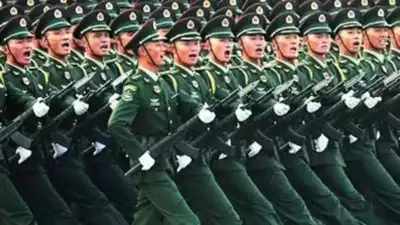China increases its defense expenditure by 7.2% in an effort to quickly modernize its armed forces
NEW DELHI: Despite a noticeable slowdown in its economic growth, China increased its annual defense budget on Tuesday by 7.2% to surpass $230 billion. This amount is more than three times India’s military spending and comes amid Beijing’s continued refusal to defuse the situation that has escalated tensions along the 3,488-km Line of Actual Control (LAC).

China’s two million-strong armed forces are being rapidly modernized primarily to prevent the US, which has an $877 billion defense budget this year, from meddling in its neighborhood, particularly in Taiwan, which it regards as a renegade province.
On the other hand, India has many reasons to be worried. China really spends a lot more on the military than it has said it would. According to a senior military commander, “China is strengthening its nuclear and conventional military capabilities as well as its strategic moves in the Indian Ocean Region (IOR), with the latest example being the free military assistance agreement with the Maldives on Monday.”
China continues to advance and deploy 50,000–60,000 troops in the western (Ladakh) and central (Uttarakhand, Himachal) sectors of the Ladakh-Arunachal conflict, as well as 90,000 soldiers in the eastern (Sikkim, Arunachal) regions, as the military standoff in eastern Ladakh approaches its four-year anniversary.
Hotan, Kashgar, Gargunsa, Shigatse, Hoping, Lingzhi, and Lhasa-Gonggar are among the air bases that face India. These facilities have been equipped with extra fighters, bombers, and AWACS (Airborne Warning & Control System). “They’re not turning around. A senior IAF officer said, “More runways, reinforced shelters, and fuel dumps have all surfaced.”
Although India has equaled other countries in terms of military deployments and is making great efforts to lessen the significant infrastructural imbalance along its borders, it has made major mistakes.
One is that India still does not obtain the necessary value for its money since there are no firm long-term plans in place to develop its military capabilities in a methodical manner. The ever-increasing costs of salaries and pensions are impeding the defense budget. Merely 28% of the defense budget of Rs 6.2 lakh crore ($75 billion) for 2024–25 is designated for military modernization. As a result, there are still operating shortages of aircraft defense weapons, guided missiles against tanks, fighters, submarines, helicopters, and similar equipment.
Two, the protracted delay in establishing theater commands has prevented India from developing an efficient integrated warfighting apparatus. India has up to four Army and three IAF commands for the northern borders, whereas China has the Western Theatre Command to manage the whole LAC. Three, despite conflicts such as the Russia-Ukraine war underscoring the need for long-range conventional (non-nuclear) missiles for precision-targeting in-depth, the Integrated Rocket Force remains a pipe dream.
Fourth, India is lagging far behind in areas like cyberwarfare and space exploration. China has been working on creating anti-satellite weapons such as direct ascent missiles, co-orbital killers, powerful lasers, and electromagnetic pulse weapons in addition to its long-standing push for “information” and “intelligentized” warfare.
Five, India still hasn’t approved the long-pending applications for nuclear-powered attack submarines, which will take many years to develop, and a third, more powerful 45,000-ton aircraft carrier. This is at a time when China is building up its logistical infrastructure and quickly growing its naval presence in the IOR.
In fact, China also keeps enhancing Pakistan’s military might. Four Type 054A/P multirole frigates have already been transferred by Beijing to Islamabad, and eight Yuan-class diesel-electric submarines are expected to be deployed in the near future. The possibility of collusion between China and Pakistan along land boundaries is now spreading to the marine sector.







